
Indicator scoreboard
EMU - November Reuters purchasing managers index rose slightly to 43.6 from 42.9 in October, the first rise since August this year. Still, the index indicated that the manufacturing sector contracted for the eighth month in a row. An index level below 50 means that the manufacturing sector contracted. The further the index below 50, the faster the contraction. The subindexes were mixed, with output and new orders up, but employment and stocks of purchases down.

November Reuters purchasing managers index of services activity rose to 46.9 from October's level of 45.1. This means that the services sector contracted for the third straight month. As in the manufacturing survey, an index reading above 50 signals that activity is expanding, a reading below 50 that it is contracting. The composite index, which combines service and industrial sector PMIs rose to 46.0 from 45.2 in October.
October seasonally adjusted unemployment rate remained unchanged at 8.4 percent. However, the September rate was revised up from 8.3 percent to 8.4 percent. Of the nine EMU states reporting data, unemployment fell in one, rose in seven and remained unchanged in five.

October industrial producer prices dropped 0.6 percent and 0.6 percent when compared with last year. Energy prices fell 2.6 percent on the month and 6.8 percent on the year. Intermediate goods prices fell by 0.3 percent and 0.8 percent on the year. The only increase was recorded for durable consumer goods, which inched up 0.1 percent and were up 1.8 percent on the year.

September real workday and seasonally adjusted retail sales rose 0.3 percent and 1.8 percent when compared with last year. The strongest sales increases when compared with last year were for textiles, clothing and footwear, books, newspapers and other sales in specialized stores and pharmaceutical and medical goods. Declines were registered for specialized store sales of food, drinks and tobacco, mail order sales of non-food products and sales of household goods.

EU - November economic sentiment index fell to 98.6 from October's 99.1 reading. This was the 11th month of deterioration in 13 months and the lowest level since May 1997. The strongest declines were registered for three of the largest economies: Germany, Spain and France. Both industrial and consumer sentiment declined. Industrial confidence fell to minus 18 from minus 16 in October. Industrial confidence fell in seven of the 12 countries. Consumer confidence fell minus 12 from minus 10 in October. Consumer confidence fell in eight countries.

Germany - Seasonally adjusted unemployment rate was unchanged at 9.5 percent. The unemployment rate in east Germany remained at 17.8 percent while in the west it rose to 7.6 percent from 7.5 percent in October. The number of seasonally adjusted unemployed rose 17,000. The increase is the 11th in as many months. The jump was due entirely to an increase of 18,000 jobless in west Germany, while the number fell 1,000 in the east.

October manufacturing orders plunged 0.9 percent as a continued drop in domestic demand offset a small rise in foreign orders. Orders fell 9.5 percent when compared with last year. Domestic demand fell 1.9 percent while foreign demand rose 0.5 percent. The foreign demand rise was the first since June and may reflect in part the effect of the weak euro exchange rate.
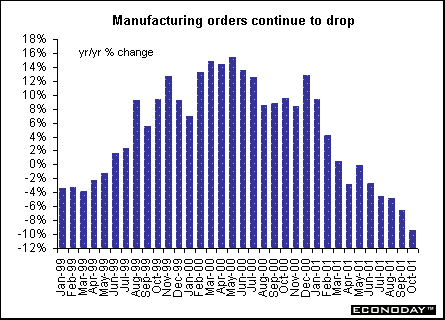
October seasonally adjusted industrial production dropped 2.1 percent and 4.0 percent when compared with last year. This follows the September drop of 1.8 percent and 2.4 percent on the year. Excluding construction, industrial production fell 2.8 percent on the month, after a drop of 1.7 percent in September. West German industrial output fell 2.3 percent while east German production rose 0.2 percent on the month. All manufacturing subcategories dropped, led by durable consumer goods, down 5.2 percent and capital goods, down 4.0 percent. Production in the basic goods sector fell 1.0 percent, while output in the non-durable goods sector fell 1.2 percent.
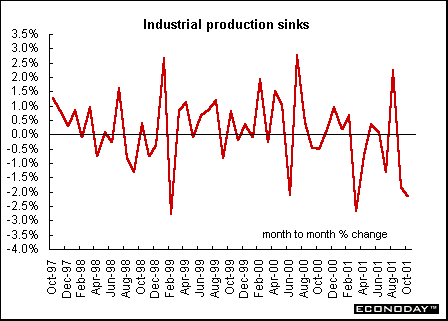
Britain - November Nationwide building society house price index rose 0.7 percent and 12.8 percent on the year. Nationwide found little evidence of the much discussed cooling of London house prices. It said that prices at the upper end of the London market had eased but there were signs of strong price increases across the rest of the capital's housing market.
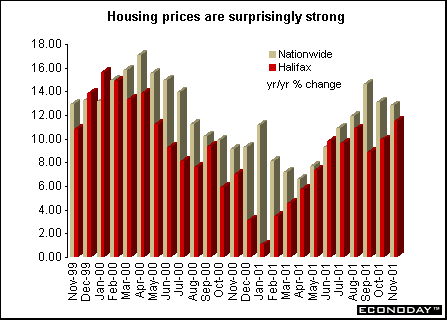
November Halifax house price index rose 2 percent and 11.5 percent when compared with last year. This was the largest monthly gain since September 2000. The price jump mainly reflects a bounce back in confidence from the lows seen in the aftermath of the September terrorist attacks.
October industrial production was down 1.1 percent and 4.2 percent when compared with last year. The data showed the negative effects of the warm weather, with output of the electricity, gas and water production industries down 2.7 percent and 4.0 percent on the year. Manufacturing output fell 0.3 percent and 4.4 percent on a year earlier. Production of new technology goods continued to fall, and the data showed output in the manufacturing, electrical and optical equipment sector down 0.8 percent, with computer and other information processing equipment dropping 2.8 percent.
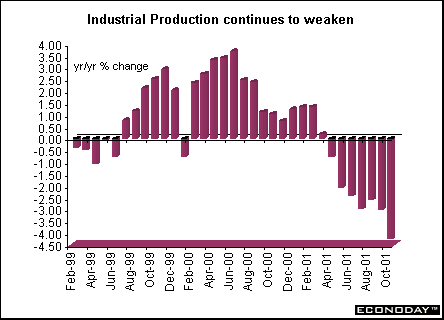
Asia
Australia - October seasonally adjusted retail sales rose 1.3 percent and 8.6 percent when compared with last year. That followed a revised 0.2 percent drop in September. It was the largest monthly gain since February. A pick-up in housing because of a government grant to first homebuilders and lower interest rates boosted consumer spending. Sales of household appliances and furnishings rose 2.7 percent.
Japan - Third quarter profits tumbled 32.5 percent from a year ago, the biggest decline in almost three years. Manufacturing company's profits plummeted 53.4 percent in the quarter, the biggest drop since 1975. Makers of electrical and general machinery led the decline. Capital spending by manufacturers fell 2.7 percent in the third quarter from a year ago after rising 10.5 percent in the second. Spending by non-manufacturers, such as builders and realtors, rose 2.4 percent in the third quarter compared to a year ago.
Third quarter gross domestic product dropped 0.5 percent and 2.2 percent on an annualized basis. That followed a 1.2 percent drop in the second quarter, revised from an initial estimate of a 0.7 percent decline. Exports fell 3.3 percent and imports rose 4.6 percent. Business spending rose 1.1 percent in the third quarter after rising 2.6 percent in the second quarter. Consumer spending fell 1.7 percent after declining 1.1 in the second quarter.
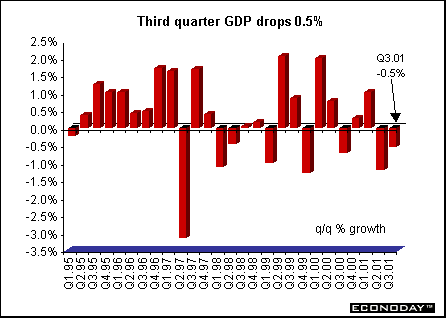
Americas
Canada - November unemployment rate rose to 7.5 percent. Although employment edged up by an estimated 14,000 despite large losses in manufacturing and transportation, a greater number of job searchers were responsible for the 0.2 increase in unemployment. Part time employment rose by 57,000 jobs but full time employment fell by 43,000 jobs.
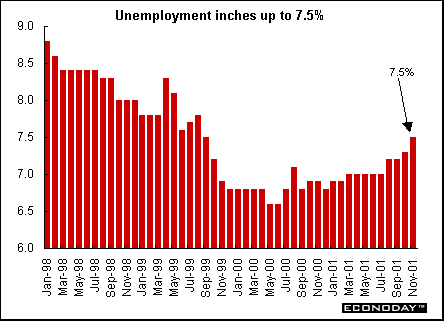


Introduction • Global
Stock Market Indexes • Recap of Global Markets
• Currencies • Indicator
Scoreboard

The Bottom Line •
Looking Ahead
|